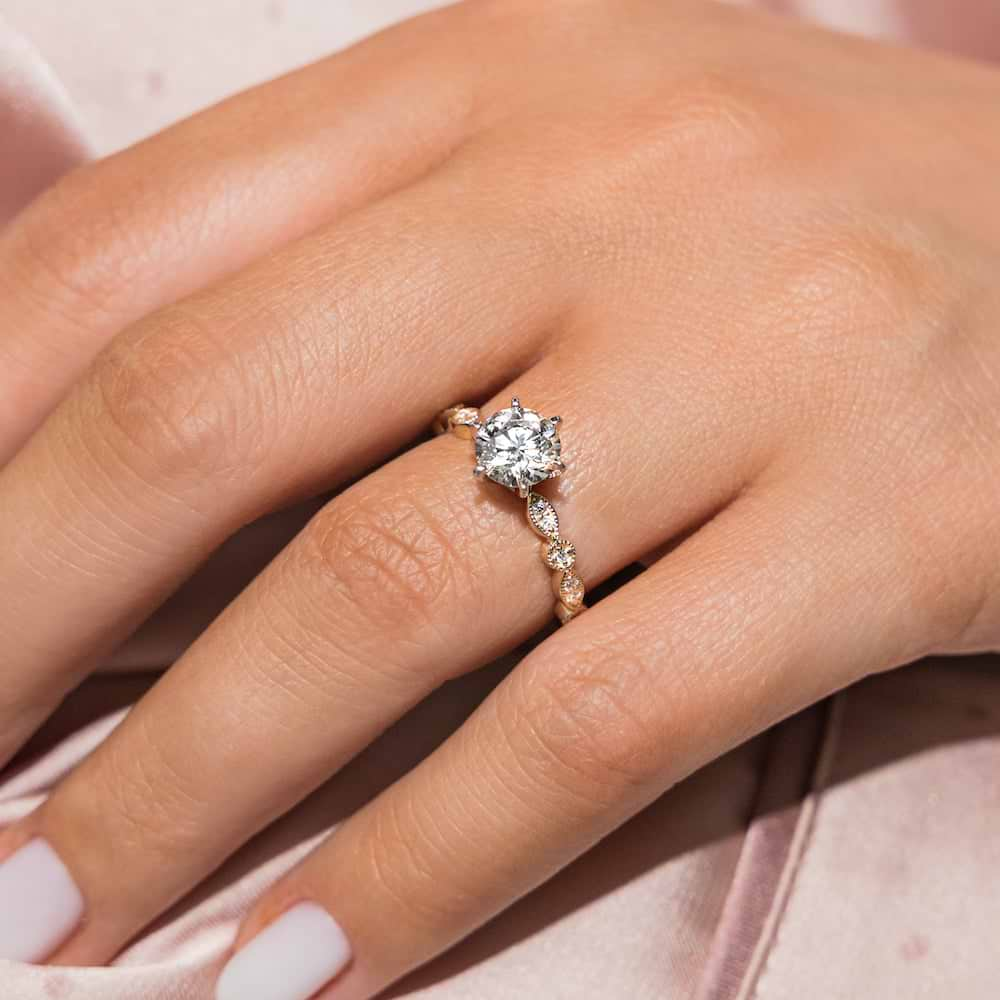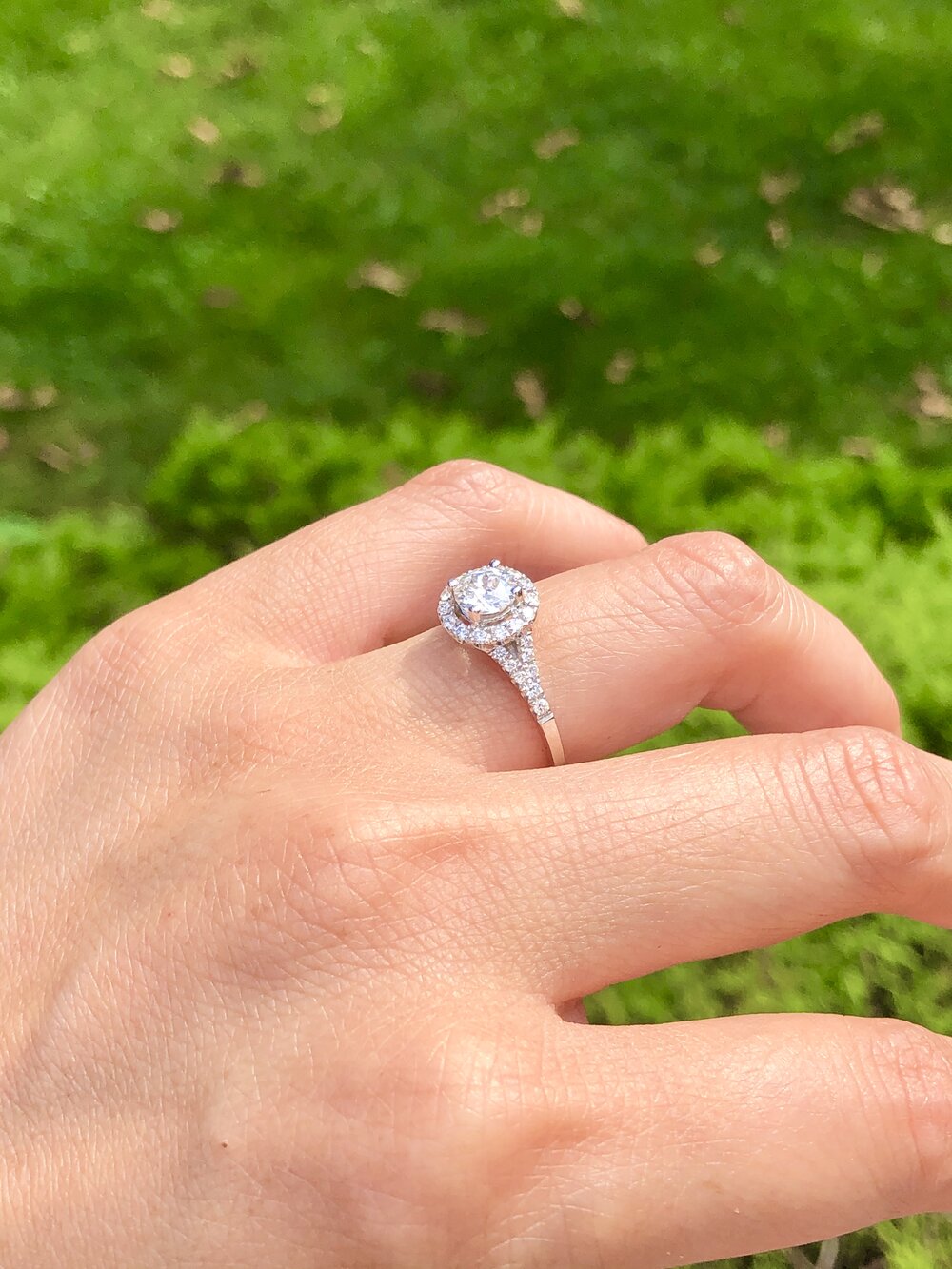The Benefits of Choosing Laboratory Grown Diamond Engagement Rings for Your Proposition
Lab-grown Diamond involvement rings provide an engaging option for couples considering their proposal alternatives. These diamonds are ethically sourced and produced in controlled environments, dealing with both ethical and environmental concerns. In addition, they provide substantial cost savings, enabling for bigger rocks or distinct designs. With advancements in modern technology, the allure of lab-grown rubies remains to grow. Recognizing these advantages can affect a couple's decision-making procedure in profound ways. What factors should be prioritized when making this selection?
Ethical Sourcing and Ecological Influence
As consumers increasingly prioritize sustainability, the increase of lab-grown Diamond interaction rings provides an engaging option to generally mined rubies. These lab-created treasures are created in controlled settings, noticeably decreasing the moral predicaments linked with Diamond mining. Conventional mining frequently entails unscrupulous labor methods and adds to environmental deterioration, consisting of logging and habitat damage.

Cost-Effectiveness: Even More Value for Your Budget plan
Lab-grown Diamond engagement rings not only line up with honest values however also provide significant cost benefits. Normally, these diamonds can be priced 20% to 40% reduced than their extracted equivalents, permitting couples to optimize their budget plans without giving up quality. This cost-effectiveness enables buyers to buy larger stones or higher-quality setups, improving the total aesthetic of the ring.
Additionally, the openness in rates connected with lab-grown rubies eliminates the concealed costs typically connected with extracted rubies, such as certification and transport fees. Pairs can also take advantage of reduced insurance costs as a result of the lowered value of lab-grown diamonds.
Therefore, selecting a lab-grown Diamond interaction ring comes to be an economically wise choice, offering pairs with even more value for their money. This price not just enables a greater selection yet likewise equips couples to pick a ring that absolutely reflects their love and dedication.
The Same Physical and Chemical Characteristics
The allure of lab-grown Diamond engagement rings lies not only in their ethical manufacturing yet additionally in their impressive physical and chemical properties. These diamonds are produced in regulated laboratory environments that simulate the natural problems under which rubies develop in the Earth. Consequently, lab-grown rubies have the exact same crystal framework and firmness as their mined equivalents, rating a best 10 on the Mohs range.
Both sorts of rubies contain carbon atoms set up in a crystal lattice, guaranteeing identical optical and physical attributes. Lab-grown rubies show the same luster, fire, and scintillation as natural diamonds, making them tantamount to the nude eye. Advanced gemological screening is required to set apart in between both, highlighting their authenticity. This parity in residential or commercial properties allows consumers to appreciate the beauty and durability of diamonds while making an environmentally aware selection.
Wider Selection of Choices
Laboratory produced Diamond interaction rings use a wider series of design alternatives that accommodate varied preferences and preferences. Their capacity to be customized enables pairs to create one-of-a-kind pieces that reflect their private style. This raised flexibility not only enhances the ring's sentimental value however likewise makes it a much more personal selection.
Distinct Layout Alternatives
While typical rubies typically include restricted design options, the surge of lab-grown Diamond interaction rings has actually opened a wider spectrum of one-of-a-kind designs and setups. This advancement enables pairs to discover more creative layouts, varying from vintage-inspired to contemporary geometric forms. Lab-grown rubies can be crafted in numerous cuts, consisting of oblong, pear, and heart shapes, providing flexibility that attract diverse tastes. Furthermore, the capacity to match these rubies with unusual band materials, such as rose gold or morally sourced steels, boosts the general visual. With distinctive settings like halo or bezel, these rings can be individualized to reflect private tales and preferences, making each engagement ring not just a sign of love, yet also a standout art piece.
Customization Possibilities
An expanding interest in lab-grown Diamond involvement rings has led to a boost in personalization opportunities, enabling couples to create genuinely tailored pieces. Unlike standard diamonds, lab-grown alternatives can be customized to fit individual preferences and preferences. Pairs can pick from a broader variety of dimensions, colors, and forms, allowing them to choose a diamond that resonates with their one-of-a-kind style. In addition, modification expands past the Diamond itself; settings can be made to match the selected rock, whether one likes timeless, modern-day, or elaborate styles. This adaptability not only enhances the emotional significance of the ring yet likewise permits a more visite site affordable method, as pairs can focus on attributes that matter most to them without jeopardizing on high quality.
Transparency in the Diamond Market
Just how can customers navigate the intricacies of the Diamond industry when openness stays a critical problem? The conventional Diamond market commonly lacks clear information pertaining to the origin and ethical sourcing of diamonds. This uncertainty can bring about customer mistrust and ethical predicaments bordering dispute rubies and environmental effect. Conversely, lab expanded rubies use a service to this transparency concern. These rubies are created in regulated settings, permitting consumers to access thorough info about their provenance.
Credible sellers of laboratory expanded diamonds normally give certificates that describe the details of the Diamond's development, including its size, top quality, and the technology made use of. This degree of transparency empowers consumers to make informed choices, straightening their purchases with personal worths. As understanding of unethical methods in the Diamond sector expands, the clear, moral nature of lab expanded rubies settings them as a compelling choice for diligent customers seeking involvement rings.
Supporting Development and Innovation
As the need for fairly sourced gems increases, sustaining innovation and innovation in the lab-grown Diamond sector comes to be important (lab grown diamond engagement rings). Lab-grown rubies, produced with innovative approaches such as High Pressure High Temperature Level (HPHT) and Chemical Vapor Deposition (CVD), stand for a substantial change in the Diamond market. Buying these modern technologies not only boosts the top quality and accessibility of rubies yet likewise reduces environmental impact contrasted to typical mining techniques
Improvements in production techniques have led to much more reliable procedures, resulting in decreased costs for customers. This technological progression cultivates competition, compelling typical Diamond manufacturers to reevaluate their practices and take the original source on even more lasting strategies. By sustaining lab-grown rubies, customers add to a market that focuses on ethical sourcing and technology, ultimately promoting a much more responsible and ecologically conscious precious jewelry industry. Embracing this Resources new period not just advantages customers yet also motivates continued innovations in gems manufacturing innovations.

Customization and Personalization Options
Laboratory grown Diamond involvement rings use a variety of personalization and modification options that accommodate individual choices. Consumers can choose distinct layout choices and tailored rock qualities, making sure that each ring reflects individual style and relevance. This capability to personalize enhances the emotional worth of the ring, making it a significant symbol of commitment.
Special Style Options
What makes a diamond interaction ring really unique? Its unique layout choices enable deep customization, reflecting the pair's distinct love tale. Laboratory produced rubies use a variety of options, from various cuts and settings to personalized inscriptions. Pairs can select from traditional jewelry to elaborate halo layouts, guaranteeing their ring lines up with individual tastes. Additionally, the versatility of lab expanded rubies makes it possible for the consolidation of tinted gems, such as emerald greens or sapphires, enhancing originality. Personalization includes the metal option, whether it's white gold, yellow gold, or climbed gold. This liberty in design not just creates an unique piece yet also symbolizes the pair's commitment, making the interaction ring a remarkable sign of their unique trip together.
Tailored Rock Characteristics
When considering the features of a ruby engagement ring, couples locate that customized rock options considerably improve the personalization procedure. Lab-grown diamonds use a series of customizable features, permitting couples to choose the size, form, and shade that best mirrors their one-of-a-kind design and choices. This flexibility enables people to produce a ring that signifies their love story. In addition, pairs can select particular quality levels and reduce styles, making sure that the Diamond not just satisfies their aesthetic needs however likewise fits their spending plan. With lab-grown diamonds, the chance for personalization extends to establishing types and steel selections, additionally boosting the ring's uniqueness. Ultimately, tailored rock qualities empower couples to create a meaningful involvement ring that truly represents their relationship.
Often Asked Questions
Exactly How Do Lab Grown Diamonds Contrast to Natural Diamonds in Regards To Sturdiness?
Laboratory expanded diamonds and all-natural rubies show similar longevity, as both are made up of carbon and share similar hardness levels. This makes them just as immune to scraping and damage, ensuring long life in any fashion jewelry setup.
Can Lab Grown Diamonds Be Marketed or Evaluated Like All-natural Diamonds?
Laboratory expanded rubies can undoubtedly be re-selled and evaluated in a similar way to natural rubies. Their resale value might differ due to market perceptions and the expanding accessibility of lab-created choices in the fashion jewelry industry.
What Is the Distinction in Sparkle Between Laboratory Grown and Natural Diamonds?

Do Laboratory Grown Diamonds Include Qualifications Like All-natural Diamonds?
Laboratory expanded rubies do come with accreditations, similar to all-natural diamonds. These qualifications validate their quality, including elements like cut, color, carat, and clarity weight, ensuring consumers obtain a trustworthy assessment of their acquisition.
Just How Are Laboratory Grown Diamonds Made to begin with?
Lab expanded rubies are created with 2 main approaches: High Pressure High Temperature Level (HPHT) simulates natural processes, while Chemical Vapor Deposition (CVD) makes use of gases to deposit carbon, permitting regulated Diamond formation in a laboratory setting. lab grown diamond engagement rings.
As customers significantly focus on sustainability, the increase of lab-grown Diamond interaction rings supplies a compelling alternative to traditionally extracted diamonds. Furthermore, the transparency in prices linked with lab-grown diamonds removes the surprise expenses typically connected with extracted rubies, such as accreditation and transport charges. Lab-grown rubies exhibit the exact same brilliance, fire, and scintillation as natural diamonds, making them identical to the nude eye. While conventional rubies commonly come with minimal style alternatives, the increase of lab-grown Diamond involvement rings has actually opened up a wider spectrum of distinct styles and settings. Lab-grown rubies, created via innovative approaches such as High Stress High Temperature Level (HPHT) and Chemical Vapor Deposition (CVD), stand for a considerable shift in the Diamond industry.